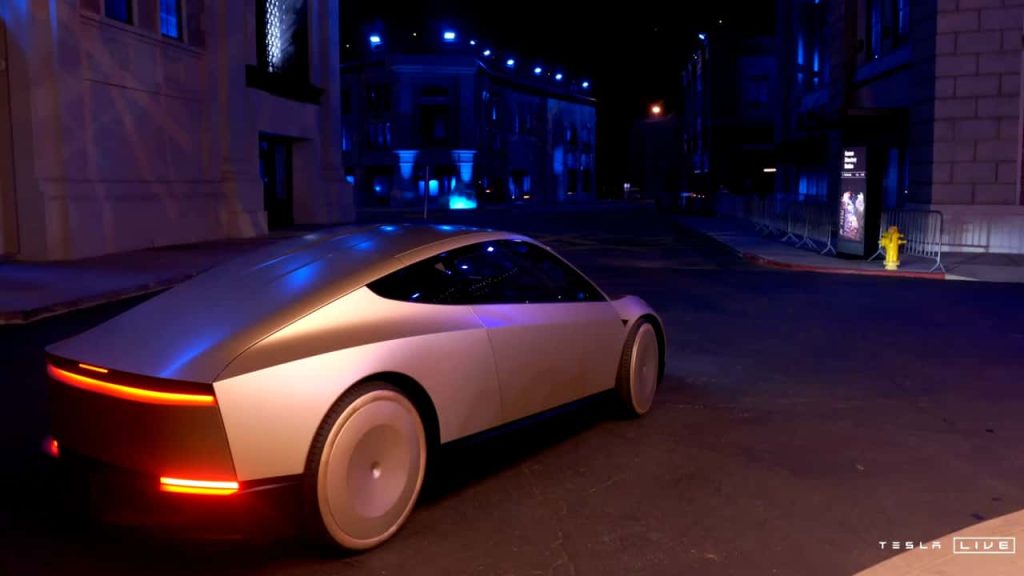
October 10, 2023 (Reuters) – At a high-profile event on Thursday, Elon Musk unveiled a striking new robotaxi featuring two gull-wing doors and no steering wheel or pedals. This announcement marks a significant shift for Tesla (TSLA.O) as it transitions from being a low-cost mass-market automaker to a robotics manufacturer, also introducing a new robovan to its lineup.
Musk arrived on stage in a prototype he dubbed the “Cybercab,” which is set to enter production in 2026 with a target price of under $30,000. He noted that the operational cost for the vehicle would be approximately 20 cents per mile, and it will utilize inductive charging, eliminating the need for plugs.
“The autonomous future is here,” Musk proclaimed. “We have 50 fully autonomous cars here tonight. You’ll see Model Ys and the Cybercab. All driverless.” He emphasized that the vehicles rely on artificial intelligence and cameras rather than the additional hardware employed by competitors in the robotaxi space—an approach that has raised concerns among investors and analysts regarding its technical and regulatory viability.
In addition to the Cybercab, Musk introduced a larger self-driving vehicle called the Robovan, which can accommodate up to 20 passengers. He also showcased Tesla’s humanoid robot, Optimus.
Musk’s vision includes operating a fleet of self-driving Tesla taxis that passengers can summon via an app. Tesla owners will have the opportunity to generate income by listing their vehicles as robotaxis on the platform.
The event, held at the Warner Bros studio near Los Angeles, was titled “We, Robot,” a nod to the “I, Robot” science-fiction stories by Isaac Asimov, and aligns with Musk’s assertion that Tesla should be viewed as an AI robotics company rather than merely an automaker. Attendees included investors, stock analysts, and Tesla enthusiasts.
However, investors hoping for concrete timelines regarding the ramp-up of robotaxi production and regulatory approvals left the event feeling underwhelmed. Dennis Dick, an equity trader at Triple D Trading, expressed disappointment, stating, “Everything looks cool, but not much in terms of timelines. I’m a shareholder and pretty disappointed. I think the market wanted more definitive timelines.”
Musk acknowledged his tendency to be optimistic with time frames. He had previously claimed in 2019 that operational robotaxis would be available by the following year. After facing missed promises, Musk has shifted his focus to developing these vehicles, abandoning plans for a smaller, more affordable car that many believed was essential to counteract slowing demand for electric vehicles (EVs).
Tesla is now at risk of posting its first-ever decline in deliveries this year, as purchasing incentives have failed to attract enough customers to its aging EV lineup. Significant price cuts aimed at offsetting high interest rates have further squeezed profit margins.
The complicated technology and strict regulations have led to billions of dollars in losses for other companies attempting to penetrate the robotaxi market, forcing some to shut down operations. Nevertheless, other firms like General Motors’ (GM.N) Cruise, Amazon’s (AMZN.O) Zoox, and several Chinese companies, including WeRide, continue to pursue this ambitious market.
Unlike competitors that rely on expensive hardware like lidar, Musk is focusing solely on cameras and AI to operate Tesla’s Full Self-Driving (FSD) system to keep costs manageable. However, FSD has faced regulatory and legal scrutiny, particularly following two fatal accidents involving the technology.
“We do expect to start fully autonomous unsupervised FSD in Texas and California next year,” Musk confirmed, specifying that this will involve the Model 3 and Model Y. He did not clarify whether the new robotaxis would utilize any new technology or depend solely on FSD.
Relevant Keywords: Elon Musk, robotaxi, Tesla, Cybercab, Robovan, autonomous vehicles, AI, electric vehicles, Full Self-Driving, robotics manufacturer, investor event.